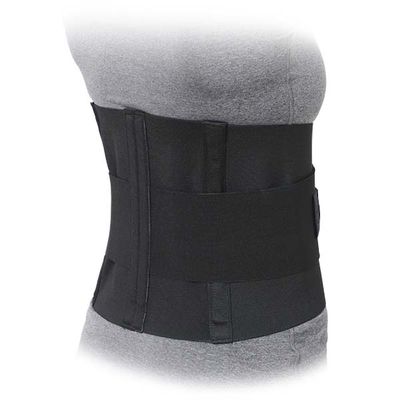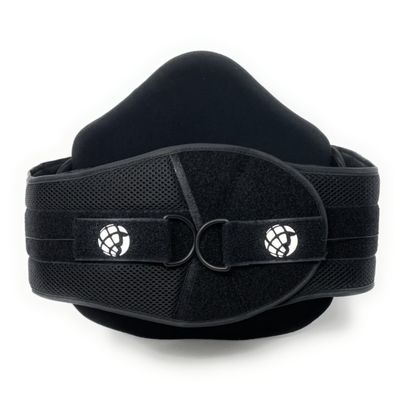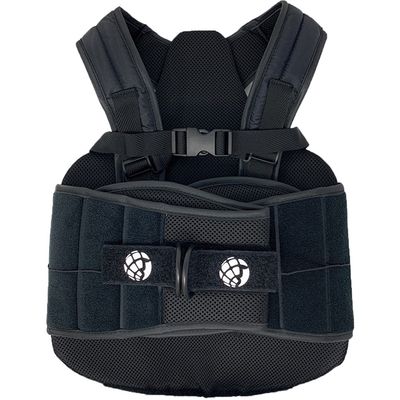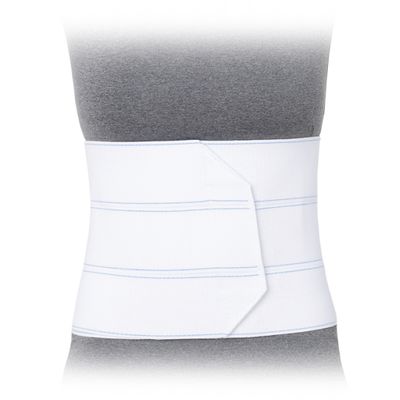
Thoraco-Lumbar Spine Brace

Table of Contents
Orthopedic Thoraco-Lumbar Brace
A thoraco-lumbar spine brace (TLSO brace) is an orthopedic device designed to support the thoracic (upper back) and lumbar (lower back) regions of the spine. It is primarily used to stabilize the spine after surgery, manage fractures, or treat conditions such as scoliosis, degenerative disc disease, and herniated discs. The brace immobilizes the spine to prevent movement, reduce pain, and promote healing by limiting flexion, extension, and rotation of the thoraco-lumbar spine.
Key Features:
- Rigid Structure: TLSO braces are often made from hard plastic materials or thermoplastic, molded to the patient’s body to ensure a close fit. This rigid structure provides maximal support and immobilization.
- Adjustable Straps: Equipped with straps and Velcro closures that allow for a customizable and snug fit, ensuring the brace stays in place during everyday activities.
- Padding for Comfort: Inside the brace, soft padding helps improve comfort and reduce the risk of skin irritation during prolonged use.
- Custom vs. Off-the-Shelf: TLSO braces can either be custom-made to fit the patient’s unique body shape or purchased in adjustable, off-the-shelf versions.
Common Conditions Treated:
- Spinal Fractures: After trauma or osteoporosis-related fractures, TLSO braces prevent further damage by stabilizing the spine.
- Post-Surgical Recovery: After spinal surgeries, particularly fusions or laminectomies, the brace aids in maintaining correct alignment while the bones heal.
- Scoliosis: For moderate scoliosis, TLSO braces may be prescribed to help slow down the progression of the spinal curvature.
- Degenerative Disc Disease and Herniated Discs: By limiting spinal movement, the brace helps alleviate pressure on discs and nerves, reducing pain.
Benefits:
- Spinal Immobilization: Limits movement to protect the spine from further injury and helps it heal.
- Pain Reduction: By keeping the spine in proper alignment and reducing unnecessary motion, it can alleviate pain caused by instability or nerve compression.
- Improved Healing: Promotes healing in both post-surgical and non-surgical cases by ensuring the spine stays properly aligned and supported.
- Prevention of Deformity Progression: In scoliosis cases, TLSO braces can slow the progression of spinal curvature, especially in younger patients during growth spurts.
A TLSO brace is often part of a larger treatment plan that may include physical therapy, medications, or surgery. It plays a critical role in both immediate post-injury care and long-term spinal health.
Lumbar Brace
The LSO brace (Lumbosacral Orthosis brace) is an orthopedic device designed to support and stabilize the lower spine, particularly the lumbar (lower back) and sacral (pelvic) regions. It is commonly used to treat conditions like lower back pain, herniated discs, post-surgical recovery, and various spinal injuries or degenerative disorders.
Key Features:
Rigid Support: An LSO brace typically features a rigid or semi-rigid frame made from plastic, metal, or composite materials. This helps immobilize the spine, restricting excessive motion that could delay healing or exacerbate injury.
Compression Straps: Adjustable straps or Velcro closures allow for a snug fit and provide targeted compression to the lower back, which helps in reducing pain and inflammation.
Contoured Design: The brace is designed to conform to the natural curvature of the lumbar spine, ensuring a comfortable fit that doesn’t compromise posture or restrict essential movements.
Anterior and Posterior Panels: The brace often includes both front (anterior) and back (posterior) panels to offer complete support around the torso, ensuring proper spinal alignment and stabilization.
Breathable Materials: Made from lightweight, breathable fabrics, many LSO braces are comfortable for extended wear, even during physical activities.
Benefits:
Post-Surgical Recovery: The LSO brace is often prescribed after spinal surgeries, such as laminectomies or fusions, to protect the operated area and promote healing.
Pain Relief: By stabilizing the spine and limiting painful movements, the brace helps relieve pain associated with conditions like sciatica, spondylolisthesis, and degenerative disc disease.
Improved Posture: By maintaining the correct alignment of the lumbar spine, the brace can help improve posture, reducing the likelihood of future injuries or pain.
Injury Prevention: It can also be used as a preventative measure for people who engage in activities that put strain on the lower back, such as heavy lifting or certain sports.
The LSO brace plays a crucial role in both recovery and daily support for individuals suffering from lower back issues, offering a balance of protection, mobility, and comfort.
Thoraco-Lumbar Pain
Thoraco-Lumbar Pain refers to discomfort or pain in the thoracic (mid-back) and lumbar (lower-back) regions of the spine. This type of pain is often associated with a variety of causes, such as injury, poor posture, overuse, or degenerative changes in the spine. Common conditions that contribute to thoraco-lumbar pain include muscle strain, herniated discs, osteoarthritis, scoliosis, and spinal stenosis.
Causes of Thoraco-Lumbar Pain:
- Muscle Strain or Ligament Sprain: Sudden twisting or heavy lifting can strain the muscles or ligaments in the thoraco-lumbar region, leading to acute pain.
- Herniated Discs: When a disc between vertebrae protrudes, it can compress nearby nerves, causing sharp pain in the lower back and radiating to the legs (sciatica).
- Osteoarthritis: Degeneration of the spine’s protective cartilage can result in pain, stiffness, and reduced mobility.
- Scoliosis or Spinal Deformities: Abnormal curvature of the spine can increase strain on muscles and joints, leading to discomfort.
- Spinal Stenosis: A narrowing of the spaces in the spine can compress nerves, causing pain and numbness.
- Fractures or Trauma: Accidents or falls may lead to vertebral fractures, especially in older adults with osteoporosis.
Symptoms:
- Pain that may radiate to the buttocks, hips, or legs.
- Stiffness or reduced flexibility in the back.
- Muscle spasms or tightness.
- Difficulty standing or walking for long periods.
Management and Treatment:
- Rest and Activity Modification: Short periods of rest combined with avoiding activities that exacerbate pain.
- Physical Therapy: Strengthening core muscles and improving posture can alleviate pain and prevent future episodes.
- Medications: Over-the-counter pain relievers like NSAIDs (ibuprofen) or muscle relaxants may be prescribed to manage pain and inflammation.
- Bracing: Wearing a thoraco-lumbar brace can help stabilize the spine, reduce movement, and promote healing.
- Heat and Cold Therapy: Alternating between hot and cold compresses can help reduce inflammation and relax muscles.
- Surgical Intervention: In severe cases, surgery may be required to correct structural issues or decompress nerves.
Prevention:
- Maintaining proper posture during daily activities.
- Regular exercise to strengthen back muscles and improve flexibility.
- Ergonomic adjustments in the workplace to reduce strain on the spine.
Thoraco-lumbar pain can vary from mild discomfort to debilitating pain, but with appropriate treatment and preventive measures, it can be effectively managed.



